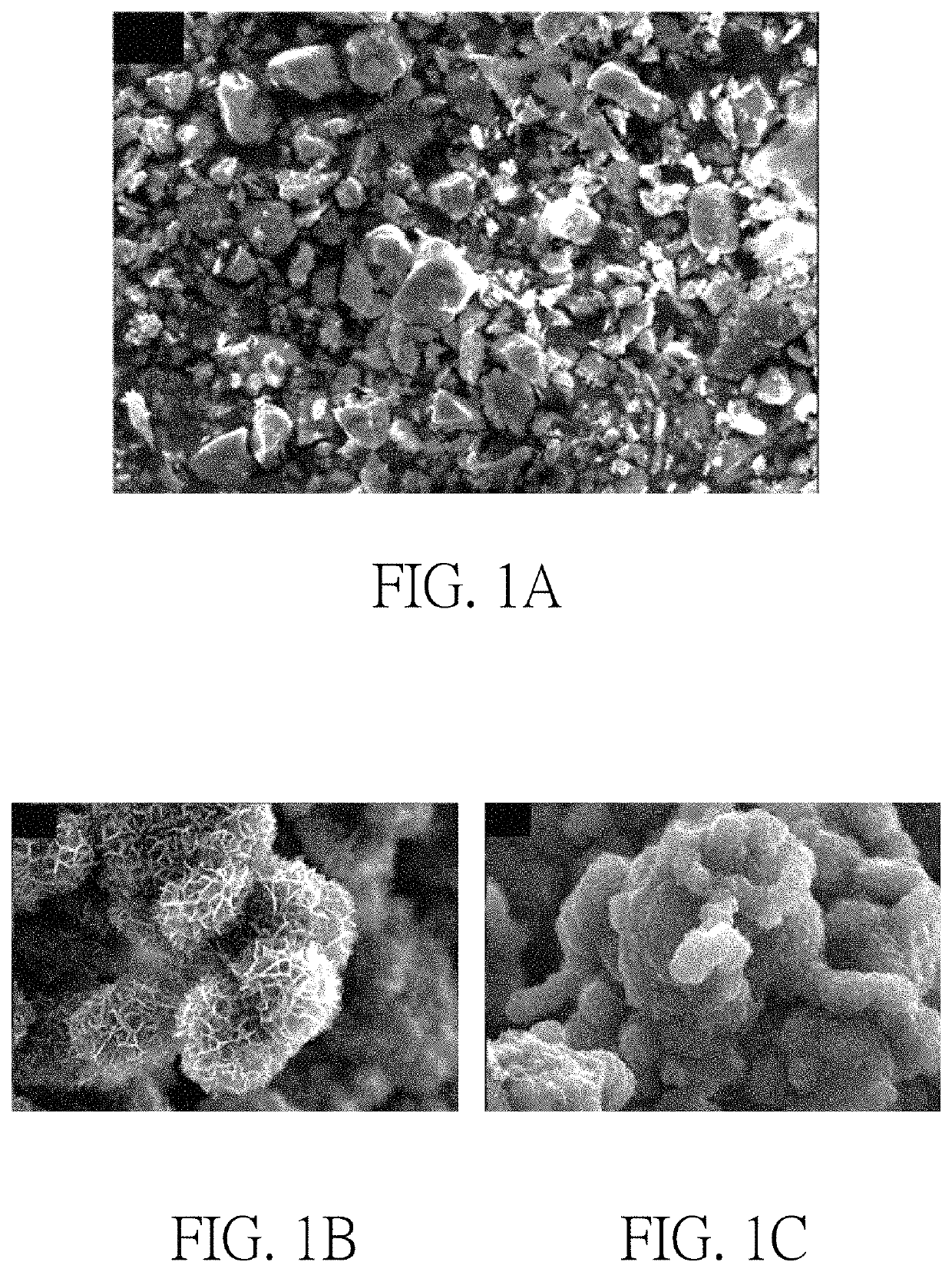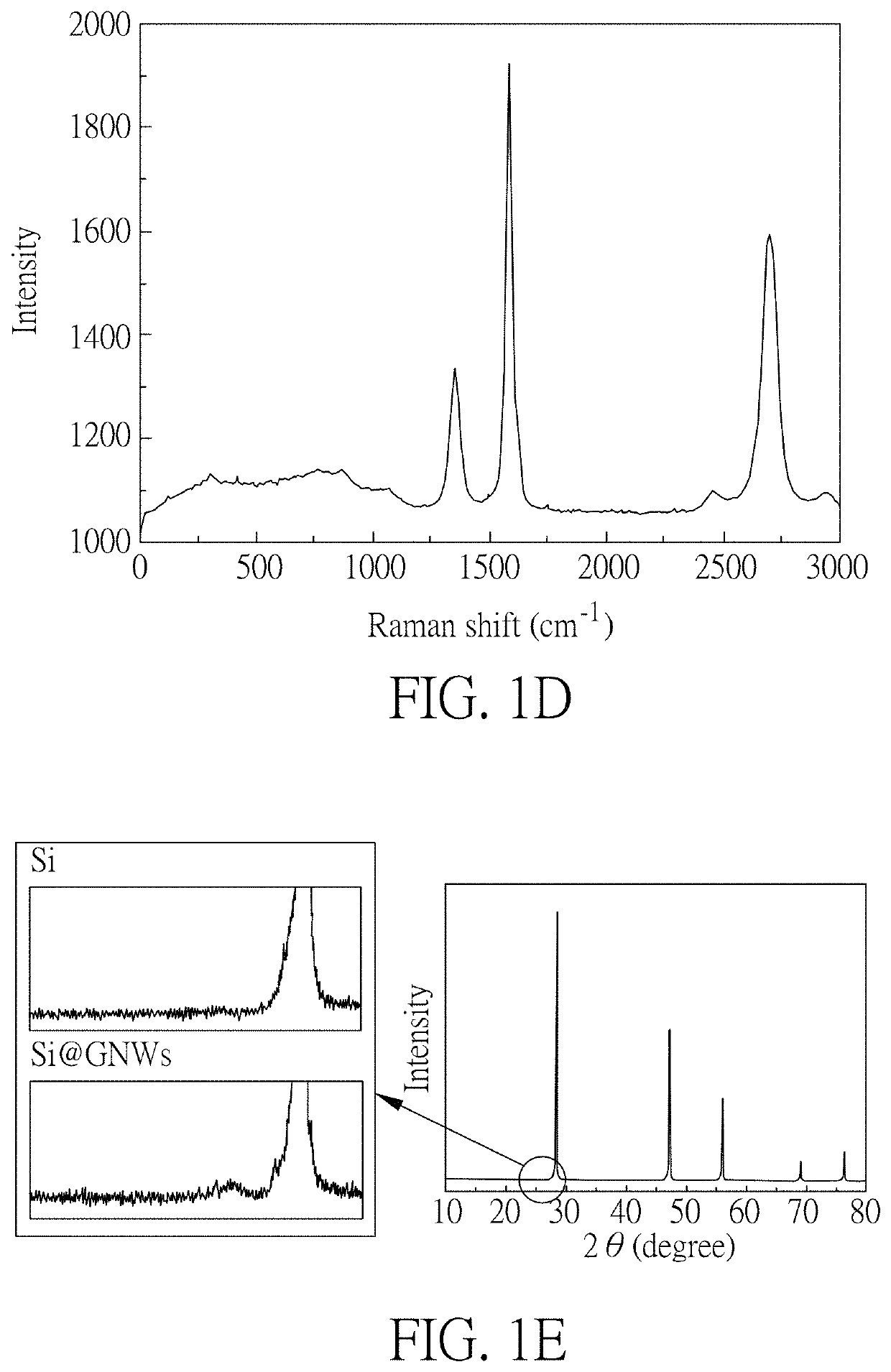Composite electrode material and method for manufacturing the same, composite electrode containing said composite electrode material, and Li-based battery comprising said composite electrode
a composite electrode and electrode material technology, applied in the direction of electrochemical generators, cell components, electrochemical generators, etc., can solve the problems of pulverized silicon particles losing conductive contact between themselves, simple graphite electrodes cannot meet the needs of the public today, and inability to achieve the effect of reducing the cost of pulverized silicon particles
- Summary
- Abstract
- Description
- Claims
- Application Information
AI Technical Summary
Benefits of technology
Problems solved by technology
Method used
Image
Examples
preparation example 1
[Preparation Example 1] Preparation of Composite Electrode Material
[0038]Silicon particles of diameter from 1 to 5 μm, flake-like silicon particles having a thickness of 200 nm, or flake-like silicon particles having a thickness of 100 nm were provided in a system of microwave plasma chemical vapor deposition (ASTex 501 system from Seki Corporation), and evacuated to a high vacuum. In the first stage, microwave plasma CVD was applied for 10 minutes at a condition of 1000 W of microwave power at 2.45 GHz of microwave frequency with 3 sccm of H2, 25 sccm of N2, and 72 sccm of Ar flow, 90 torr gas pressure, and about 850° C. silicon temperature to remove the native oxide layer on the surface of the silicon particles. In the second stage, microwave plasma CVD was carried out for 30 minutes at a condition of 1000 W of microwave power, 2.45 GHz of microwave frequency, 5 sccm of CH4, 25 sccm of N2, 70 sccm of Ar gas flow, 90 torr gas pressure, and up to about 1200° C. silicon temperature t...
preparation example 2
[Preparation Example 2] Preparation of a Composite Electrode
[0041]The composite electrode material prepared as described above, conductive carbon black, and adhesive NaCMC were mixed at a weight ratio of 6:3:1. And then the mixture was added with deionized water, and stirred with a DC stirring machine until the mixture was even to obtain an active material. The active material was provided in a vacuum chamber, evacuated to a low pressure to remove trapped vapor and gases from the active material, and followed by using a scraper to coat on a copper foil (10 μm) with the active material (30 μm of thickness) to obtain an electrode. After that, the coated electrode was provided in a vacuum oven, evacuated to a vacuum, and baked at 65° C. for 12 hours to remove excess solvent. After cooling, a roller press machine was applied to roll the baked electrode to increase the packaging density of the electrode. Finally, a cutter knife was applied to obtain an electrode with desired sizes.
preparation example 3
[Preparation Example 3] Preparation of Lithium Half-Cell
[0042]FIG. 2 showed a schematic of the Li-based battery of the present embodiment. Here, a composite electrode 4 prepared as described above, which was used as a negative electrode, a metal bottom cover 1, a lithium counter electrode 2, a separator 3 (Celgard 2355), a metal gasket 5, a metal spring 6, and a metal top cover 7 were provided in a glove box. Further, 1M LiPF6 solution dissolved in EC / DEC (1:1 v / v) was used as an electrolyte 8. The abovementioned materials were assembled into a button cell in accordance with FIG. 2, and then sealed with a battery packaging machine to form a lithium half-cell of the present embodiment. However, this embodiment is merely illustrative, and the lithium half-cell of the present invention is not limited thereto.
[0043]As shown in FIG. 2, the lithium battery of the present embodiment comprised: a composite electrode 4 prepared as described above; a lithium counter electrode 2; a separator 3...
PUM
| Property | Measurement | Unit |
|---|---|---|
| thickness | aaaaa | aaaaa |
| thickness | aaaaa | aaaaa |
| length | aaaaa | aaaaa |
Abstract
Description
Claims
Application Information
 Login to View More
Login to View More - R&D
- Intellectual Property
- Life Sciences
- Materials
- Tech Scout
- Unparalleled Data Quality
- Higher Quality Content
- 60% Fewer Hallucinations
Browse by: Latest US Patents, China's latest patents, Technical Efficacy Thesaurus, Application Domain, Technology Topic, Popular Technical Reports.
© 2025 PatSnap. All rights reserved.Legal|Privacy policy|Modern Slavery Act Transparency Statement|Sitemap|About US| Contact US: help@patsnap.com



